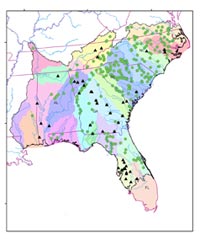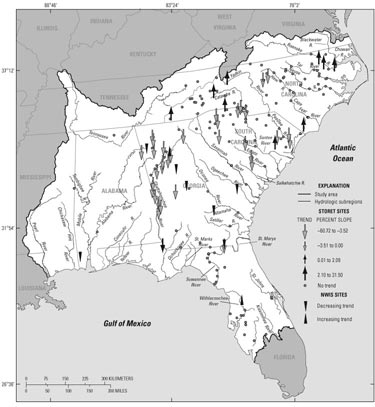|

Project Overview
Full Title
ALBE NAWQA
Location
 Souteastern United States Souteastern United States
Project Chief
Douglas Harned
Period of Project
2001-2010
Team Members
Melinda Chapman
Michelle Moorman
Thomas Cuffney
Ana María García
Gerard McMahon
Eric Staub
Silvia Terziotti
USGS IN YOUR STATE
USGS Water Science Centers are located in each state.

|
Albemarle-Pamlico NAWQA
1 - Major River Basin 2 study (MRB2):
Trends in Water Quality in the Southeastern United States, 1973-2005
Water-quality data for 334 streams in 8 states of the Southeastern United States were assessed for trends from 1973 to 2005. Forty-four U.S. Geological Survey sites were examined for trends within the period of 1973-2005 in pH, specific conductance, and dissolved oxygen, and in concentrations of dissolved solids, suspended sediment, chloride, sodium, sulfate, silica, potassium, carbon, total nitrogen, total ammonia, total ammonia plus organic nitrogen, dissolved nitrite plus nitrate, and total phosphorus. An additional 290 sites from the U.S. Environmental Protection Agency Storage and Retrieval (STORET) database were tested for trends in total nitrogen and phosphorus concentrations for the 1975-2004 and 1993-2004 periods. The seasonal Kendall test or Tobit regression was used to detect trends. Concentrations of dissolved constituents have increased in the Southeast during the last 30 years. Specific conductance increased at 62 percent of the sites, and pH increased at 31 percent of the sites. Decreasing trends in total nitrogen were detected at 49 percent of the sites. Ammonia concentrations decreased from at 27 percent of the sites and nitrite plus nitrate concentrations decreased at 32 percent of the sites. These results indicate that the changes in stream nitrogen concentrations generally coincided with improved municipal wastewater treatment methods. Concentrations of phosphorus have decreased over the last 35 years which coincided with phosphate-detergent bans and improvements in wastewater treatment that were implemented beginning in 1972. Long-term decreasing trends in total phosphorus were detected at 56 percent of the sites. Multiple regression analysis indicated a relation between changes in atmospheric inputs and agricultural practices, and changes in water quality. A long-term water-quality and landscape trends-assessment network for the Southeast is needed to assess changes in water quality over time in response to variations in population, agricultural, wastewater, and landscape variables.

Click to enlarge
Recent (1973-2005) trends in total phosphorus concentration at sites from the National Water Information System (NWIS) and Storage and Retrieval (STORET) databases.
Publications:
Staub, E.L., Peak, K.L., Tighe, K.C., Sadorf, E.M., and Harned, D.A., 2009, Data used in analysis of trends, and nutrient and suspended-sediment loads for streams in the Southeastern United States, 1973–2005: U.S. Geological Survey Data Series 488.
Harned, D.A., Staub, E.L., Peak, K.L., Tighe, K.M., and Terziotti, Silvia, 2009, Trends in water quality in the Southeastern United States, 1973–2005: U.S. Geological Survey Scientific Investigations Report 2009–5268, 25 p.
|
